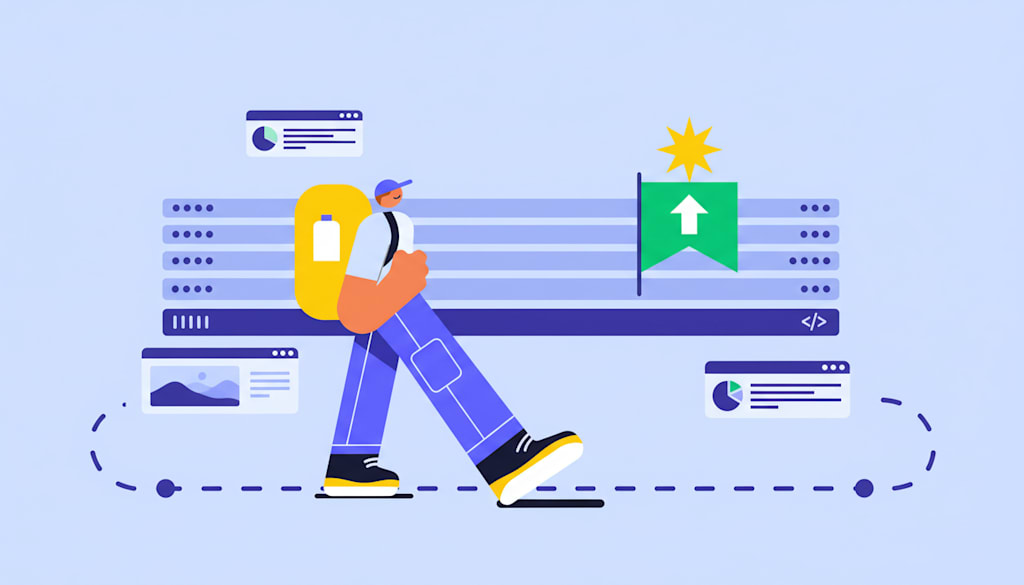Your star performer just quit. The project manager who seemed engaged last month is now missing deadlines. Meanwhile, your highest-potential team member feels overlooked and is quietly interviewing elsewhere — all because outdated annual reviews capture performance months too late to matter.
In this guide, you’ll discover how to build a performance management system that connects individual work to strategic success in real time. We’ll show you how to evaluate your current processes, select the right approach for your organization, and create a single source of truth where work happens and performance is measured.
Try monday work managementKey takeaways
- Replace outdated annual reviews with continuous, data-driven performance visibility that reflects how work actually happens in real time.
- Connect individual tasks to strategic goals so employees understand how their daily work directly contributes to organizational outcomes.
- Use AI to surface performance patterns, predict risks, and flag issues early — enabling proactive coaching and smarter resource decisions, not automated judgment.
- Shift performance management from evaluating past results to developing future capability through regular feedback, skill building, and clear growth pathways.
- An integrated work management platform automatically captures performance data as teams complete projects, eliminating manual tracking while providing real-time visibility into goal progress across all initiatives.
What is a performance management system?
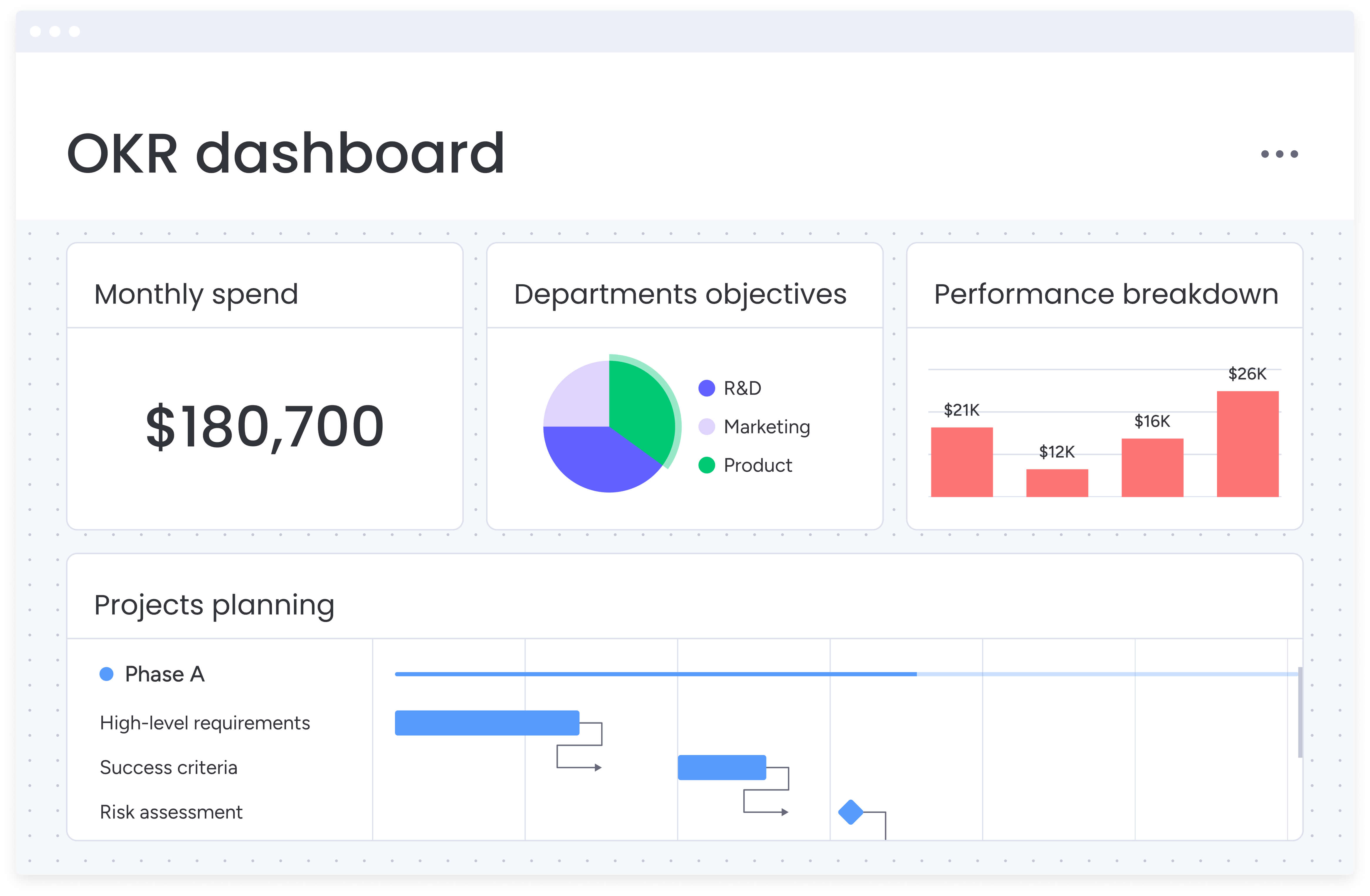.jpg)
A performance management system is a structured approach organizations use to measure, guide, and improve employee performance in alignment with business objectives. This means moving beyond annual reviews to create ongoing visibility into how individuals and teams contribute to organizational success.
Unlike traditional performance reviews that capture past performance once or twice yearly, performance management systems track progress continuously through objective data. This shift is critical given that 26% of employees received no feedback in the past year, highlighting the need for more frequent performance conversations. They monitor project completion rates, goal achievement, collaboration patterns, and work quality metrics. This ongoing visibility lets managers address issues proactively rather than discovering problems months later.
At their heart, performance management systems accomplish 3 critical functions that bridge the gap between daily work and strategic outcomes. Understanding these pillars helps leaders see how a well-designed system moves beyond simple tracking to actively drive business success.
- Establishing expectations: Connect individual work to strategic goals so everyone understands their contribution.
- Enabling continuous feedback: Facilitate regular check-ins, coaching conversations, and skill-building opportunities.
- Providing data-driven insights: Help leaders make informed decisions about resources, priorities, and interventions.
Why modern organizations need performance management systems
Let’s face it — work looks nothing like it did 5 years ago. With teams spread across time zones and markets changing quarterly, organizations need a more agile way to manage performance that keeps pace with modern business.
Drive strategic alignment across teams
When every team is aligned, companies can direct all their resources toward high-impact projects that move the needle on strategic priorities. Performance management systems solve this by creating line-of-sight from individual activities to organizational objectives, with 86% of employees reporting they know how their work relates to their organization’s goals.
When marketing managers see how campaigns contribute to quarterly revenue goals, or product teams understand how sprint work connects to innovation targets, strategic alignment becomes tangible. These systems enable goal cascading — breaking down organizational objectives into team goals and individual contributions.
Instead of vague directives, performance management translates objectives into specific, measurable actions:
- Reduce support ticket resolution time by 20%
- Increase NPS scores by 15 points
- Launch 3 new self-service resources
Enable real-time decision making
Annual performance reviews force managers to make critical decisions based on outdated information. By the time reviews happen, context has changed, team dynamics have shifted, and performance patterns have evolved.
With the right performance system, you’ll keep your finger on the pulse of what really matters:
- Project delivery rates: Track completion patterns across teams
- Collaboration effectiveness: Monitor cross-functional work quality
- Goal progress: See advancement toward objectives in real time
- Skill development: Identify growth areas and training needs
When teams consistently miss deadlines, managers can intervene immediately with additional resources or scope adjustments. This real-time visibility supports resource allocation decisions — if portfolio dashboards show certain initiatives falling behind while others have excess capacity, leaders can redistribute talent to match priorities. Instead of discovering delivery issues in quarterly reviews, managers can rebalance capacity mid-sprint.
Support distributed workforce success
Remote and hybrid environments require a shift toward objective, output-based performance indicators. This allows managers to focus on measurable contributions rather than physical presence. With 13.3% of U.S. workers working from home in 2024, performance management systems must establish objective measures that work regardless of location.
These systems establish consistent communication rhythms across distributed teams. Regular check-ins, documented feedback, and transparent goal tracking ensure remote employees receive the same development attention as on-site colleagues. When performance data lives in a shared platform accessible to all team members, geographic distance becomes irrelevant to performance visibility.
Core components of effective performance management
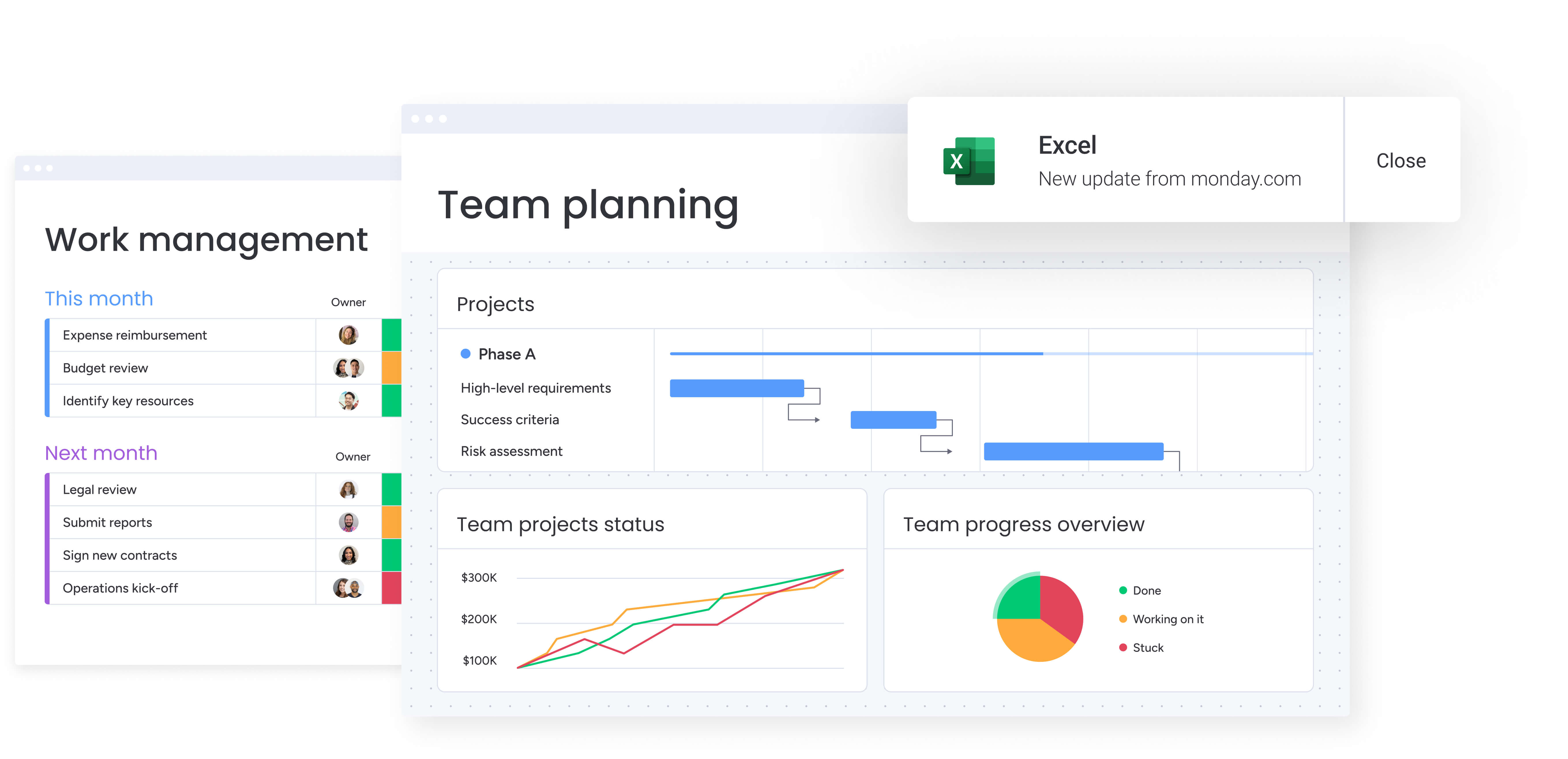
Get these 5 elements right, and you’ll know if you’re investing in real improvement or just adding more paperwork. Each component serves a specific purpose in creating a comprehensive approach that drives both individual and organizational success.
Each element plays a distinct role in creating a comprehensive performance management approach:
- Strategic goal alignment: Connects individual work to organizational objectives through goal cascading and OKR integration
- Continuous performance tracking: Monitors progress through ongoing data collection from project completion rates, collaboration patterns, and goal achievement metrics
- Data-driven analytics: Transform raw information into actionable insights through dashboards that highlight trends, identify high performers, and flag at-risk projects
- Employee development planning: Identifies skill gaps and creates personalized pathways based on performance data and career aspirations
- Integrated recognition programs: Incorporate both formal and informal mechanisms that reinforce desired behaviors and celebrate achievements
Key benefits of performance management
The right performance management system is more than an HR checkbox; it drives real business results that executives and department leaders can see in their numbers.
Enhanced employee engagement and retention
When team members understand exactly what success looks like, receive regular feedback on their progress, and see connections between their contributions and organizational outcomes, engagement increases measurably.
The retention impact is equally significant. Employees leave organizations when they feel undervalued, unclear about growth opportunities, or disconnected from meaningful work. Performance management systems address all 3 drivers:
- Document contributions: Make individual impact visible and measurable
- Create development pathways: Show advancement opportunities based on performance data
- Connect daily work to strategic impact: Help employees see how their efforts matter
Improved organizational performance
Performance management systems accelerate goal achievement through increased accountability, resource allocation, and faster course correction. When every initiative connects to measurable objectives and progress is visible in real time, teams maintain focus on high-impact activities.
The productivity gains come from multiple sources:
- Clear expectations: Eliminate wasted effort on work that doesn’t align with priorities
- Continuous feedback: Enable faster skill development and performance improvement
- Data-driven allocation: Ensure the right people work on the right initiatives at the right time
Greater cross-functional collaboration
Silos emerge when teams lack visibility into each other’s work, priorities, and constraints. Performance management systems break down these barriers by creating shared visibility into how different departments contribute to common objectives.
When marketing can see how product development progresses toward launch goals, and sales understands how customer success metrics impact renewal targets, cross-functional coordination improves dramatically. Teams using monday work management experience this visibility naturally through the platform’s unified workspace — performance data flows across departmental boundaries without requiring separate reporting processes.
Try monday work managementTypes of performance management systems
Different performance management approaches suit different organizational needs, cultures, and operational models. Understanding these 4 types helps organizations select the approach that best matches their current maturity and future aspirations.
Here’s a quick-look table to compare the 4, with longer explanations after the table.
| Type | Key characteristics | Best for | Limitations |
|---|---|---|---|
| Traditional review-based | Annual or semi-annual reviews, standardized rating scales, manager-led evaluations | Stable roles, regulated environments, compliance-driven organizations | Backward-looking, infrequent feedback, poor fit for fast-changing work |
| Continuous performance management | Regular check-ins, ongoing feedback, quarterly goal reviews | Knowledge work, development-focused cultures, dynamic environments | Requires strong manager capability and time investment |
| Agile performance frameworks | Sprint-based reviews, team-level metrics, iterative improvement cycles | Product, engineering, project-based teams using Agile methods | Team-focused metrics can miss individual development without structure |
| Integrated work management | Performance insights generated directly from daily work execution | Cross-functional, distributed, execution-driven organizations | Requires a unified work management platform |
Traditional review-based systems
Traditional performance management relies on annual or semi-annual review cycles where managers assess employee performance using standardized rating scales and competency frameworks. These systems emphasize documentation, consistency, and formal evaluation processes.
While this approach still serves organizations with stable roles and compliance requirements, it struggles in fast-moving environments. Performance feedback arrives too late to influence outcomes, and reviews often reflect outdated priorities rather than current business needs.
Continuous performance management
Continuous performance management replaces periodic reviews with frequent feedback, regular check-ins, and ongoing goal adjustments. Managers and employees meet monthly or quarterly to discuss progress, remove obstacles, and recalibrate priorities as work evolves.
This approach improves development and engagement but depends heavily on manager skill. Without strong coaching capabilities and clear expectations, continuous feedback can become inconsistent or subjective.
Agile performance frameworks
Agile performance frameworks align performance evaluation with Agile delivery cycles. Feedback happens during sprint reviews and retrospectives, focusing on outcomes, collaboration, and continuous improvement rather than static annual goals.
These frameworks emphasize team-level metrics such as velocity, cycle time, and delivery predictability. While effective for product and engineering teams, Agile approaches often require complementary systems to support individual development, career progression, and organization-wide visibility.
Integrated work management approaches
Integrated work management approaches generate performance insights directly from how teams execute daily work. Instead of relying on separate review processes, performance data emerges naturally from project completion rates, collaboration patterns, and goal progress tracked in a unified platform.
Platforms like monday work management connect every initiative to strategic objectives, automatically updating performance insights as work gets done. This approach reduces administrative overhead while providing real-time visibility into both team and organizational performance.
How AI transforms performance management
Artificial intelligence transforms performance management from a primarily retrospective, manager-driven process into a proactive, insight-rich system. AI identifies patterns, predicts outcomes, and recommends actions that human reviewers might miss, creating opportunities for more strategic performance management.
AI-driven performance analytics
AI doesn’t just look at one performance metric at a time – it spots connections across your entire dataset that even your sharpest managers would miss. While managers might notice that team members consistently deliver projects late, AI can identify that late deliveries correlate with specific project types, team compositions, or resource constraints. This deeper analysis reveals root causes rather than just symptoms.
Machine learning algorithms detect performance trends before they become obvious to human observers. If an employee’s collaboration patterns change, AI flags this as an early indicator of disengagement or burnout. Managers can then have proactive conversations to address issues before performance significantly declines.
Predictive talent intelligence
AI’s predictive capabilities transform how organizations manage talent development and retention. By analyzing historical performance data, career progression patterns, and engagement indicators, AI can predict which employees are likely to leave, which are ready for promotion, and which need specific development interventions.
Flight risk prediction is one of the most valuable AI applications in performance management. AI identifies early warning signs that often precede voluntary departures. When the system flags a high performer as at-risk, managers can intervene with development opportunities or career conversations that address underlying concerns.
For example, AI might flag declining collaboration activity across project boards, prompting managers to check in — not to penalize, but to prevent burnout.
Teams leveraging monday work management benefit from Portfolio Risk Insights that scan project boards to flag potential risks by severity, giving leaders visibility into performance challenges across the organization. This proactive risk identification enables managers to intervene before small issues become major problems.
7 must-have features for performance management systems
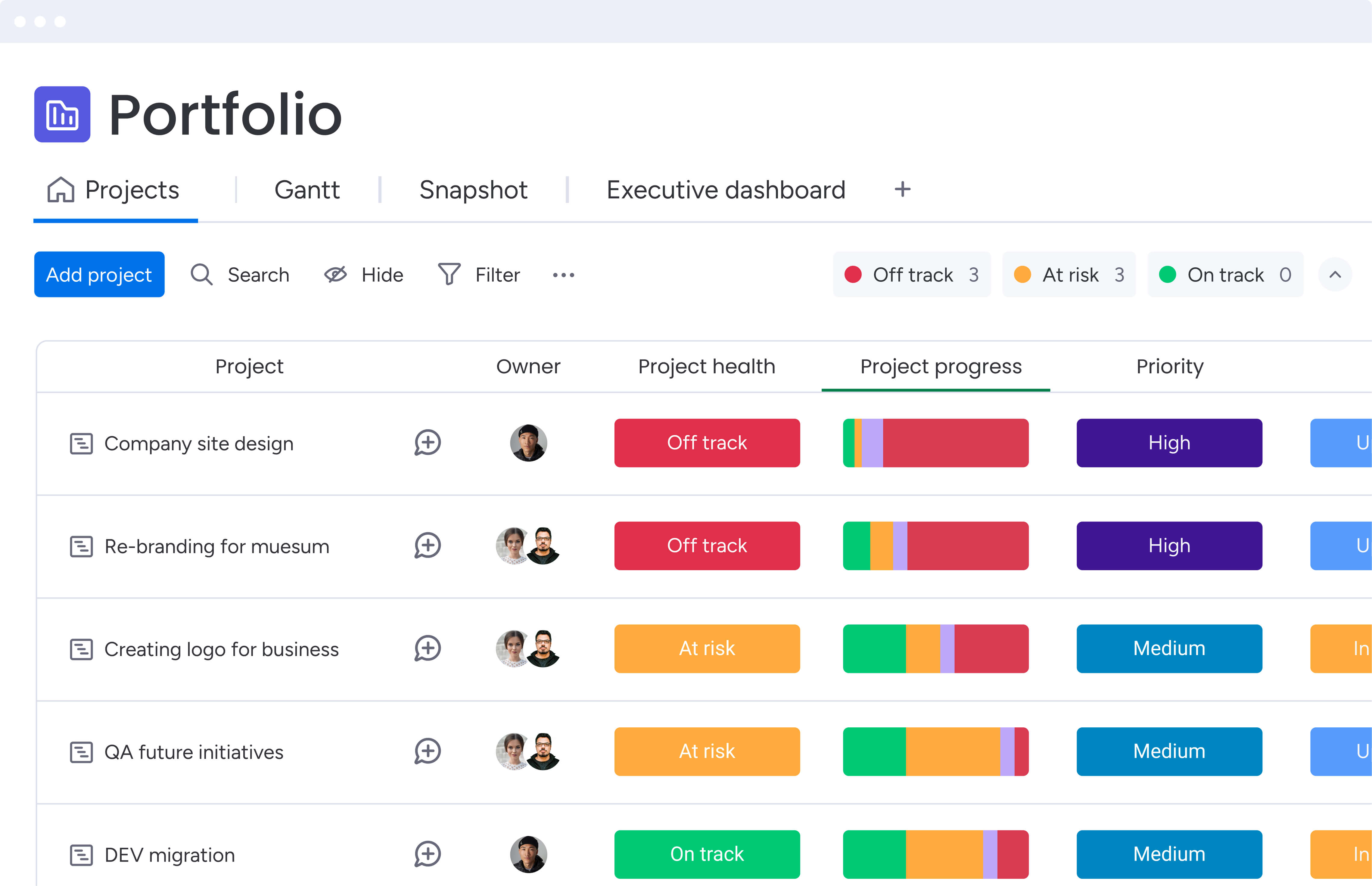
These 7 features distinguish performance management systems that drive meaningful improvement from those that simply add administrative burden. Organizations evaluating systems should prioritize these capabilities to ensure their investment delivers sustained value.
1. Visual performance dashboards
Effective systems present complex data through intuitive dashboards that make performance trends immediately apparent. These dashboards are customized for different audiences:
- Executives: Portfolio-level metrics and strategic goal progress
- Managers: Team performance and individual contributor insights
- Individual contributors: Personal progress tracking and development goals
2. Cross-portfolio visibility
Performance management systems must provide organization-wide visibility that breaks down departmental silos. When marketing can see product development progress and finance tracks initiative ROI in real time, cross-functional coordination improves dramatically.
3.Mobile-accessible performance insights
Modern workforces expect to access performance information from any device, anywhere. Managers should be able to provide feedback, review goal progress, and acknowledge achievements from their phones.
4. Seamless integrations
Performance management systems must connect with the platforms teams already use. These integrations eliminate manual data entry and ensure performance data reflects actual work rather than requiring separate documentation.
5. Customizable workflows
Every organization has unique performance management processes shaped by industry requirements, company culture, and operational models. Systems must accommodate this diversity through flexible workflow configuration.
6. Advanced reporting capabilities
Performance management generates enormous amounts of data that becomes valuable only when transformed into actionable insights. Advanced reporting includes:
- Pre-built reports: Common analyses ready to use
- Custom report builders: Flexible tools for specific organizational needs
- Scheduled distribution: Automatic delivery to relevant stakeholders
7. AI-powered insights
AI capabilities transform performance management from reactive to proactive by identifying patterns, predicting outcomes, and recommending actions.
How to implement a performance management system in 6 steps
Building a performance management system that actually works isn’t about buying software and hoping for the best. It requires a deliberate approach that addresses your current gaps, defines what success looks like, and brings teams along through the transition. These 6 steps guide you from evaluation through full-scale implementation.
Step 1: Evaluate your current performance processes
First, take a hard look at how you’re managing performance today. What’s working? What’s falling flat? Where can you make the biggest impact? Document current pain points from multiple perspectives — employees, managers, and executives often experience different frustrations with the same processes.
Key questions to ask during this evaluation:
- Frequency: How often do managers and employees discuss performance?
- Data sources: What information informs these discussions?
- Goal connection: How do current processes connect individual performance to organizational goals?
- Technology gaps: Where do manual processes create inefficiencies?
- Satisfaction levels: How do different stakeholders rate the current system?
Step 2: Define success metrics
Establish specific, measurable goals for the performance management system that align with organizational priorities. These metrics should include both quantitative measures and qualitative indicators to capture the full impact of your investment.
Quantitative metrics might include:
- Adoption rates: Percentage of teams actively using the system
- Goal completion: Achievement rates for individual and team objectives
- Review frequency: Number of check-ins completed per quarter
- Time savings: Reduction in administrative overhead
Qualitative indicators could encompass:
- Manager confidence: Comfort level with performance conversations
- Perceived fairness: Employee trust in the evaluation process
- Development quality: Effectiveness of growth planning
- Cultural alignment: How well the system supports organizational values
Step 3: Select the right solution
Evaluate performance management systems against both technical capabilities and organizational fit. Consider how different systems approach the fundamental question of where performance data originates. Traditional systems require separate data entry, while work management platforms generate performance insights from actual work execution.
Key evaluation criteria include:
- Integration capabilities: How well does the system connect with existing tools?
- Scalability: Can the platform grow with your organization?
- User experience: Will teams actually want to use this system?
- Customization options: Does it accommodate your unique processes?
Step 4: Design your implementation roadmap
Plan a phased rollout that builds momentum, enables learning, and minimizes disruption. Most successful implementations follow a pilot-scale-optimize pattern — start with a small pilot group, expand based on lessons learned, and continue scaling while refining processes.
Your roadmap should include:
- Pilot phase: Test with 1-2 teams for 30-60 days
- Feedback integration: Refine processes based on pilot learnings
- Department rollout: Expand to full departments over 3-6 months
- Organization-wide deployment: Complete rollout with ongoing support
Step 5: Enable managers and teams
Manager capability directly determines performance management system success. Training should be role-specific and practical, covering both technical proficiency with the system and performance management capabilities like giving feedback and conducting coaching conversations.
Training components should include:
- System navigation: Technical skills for using the platform
- Coaching techniques: How to conduct effective performance conversations
- Goal setting: Creating meaningful, measurable objectives
- Feedback delivery: Providing constructive, actionable input
Step 6: Launch, measure, and scale
When you launch, you’ll shift from setup mode to actually running the system. Focus on tracking who’s using it, collecting honest feedback, and giving teams the support they need. Early launch weeks are critical for forming first impressions and building momentum.
Focus on these launch activities:
- Communication campaigns: Keep teams informed about benefits and expectations
- Support resources: Provide help documentation and training materials
- Adoption tracking: Monitor usage patterns and identify support needs
- Continuous improvement: Gather feedback and refine processes regularly
Performance management best practices
The workplace continues evolving, and performance management practices must adapt to remain effective. These forward-looking practices address current trends in distributed work, AI adoption, and strategic agility while maintaining focus on human development and organizational success.
- Build a culture of continuous feedback: Prioritize frequent, specific feedback tied directly to work in progress. Short, timely check-ins drive more improvement than infrequent formal reviews.
- Use AI to augment, not replace, managers: Apply AI for pattern detection, risk signals, and trend analysis, while keeping coaching, context, and final judgment firmly human-led.
- Link performance directly to strategic objectives: Connect projects, goals, and daily tasks to organizational priorities so employees can see how their work contributes to measurable outcomes.
- Empower managers as performance coaches: Equip managers with coaching skills, clear frameworks, and performance data so conversations focus on growth, not just evaluation.
These practices work together to create a performance management approach that adapts to modern work realities while keeping human development at the center. When you combine continuous feedback, AI-powered insights, strategic alignment, and coaching-focused managers, you build a system that drives both individual growth and organizational success.
Achieve performance excellence with monday work management
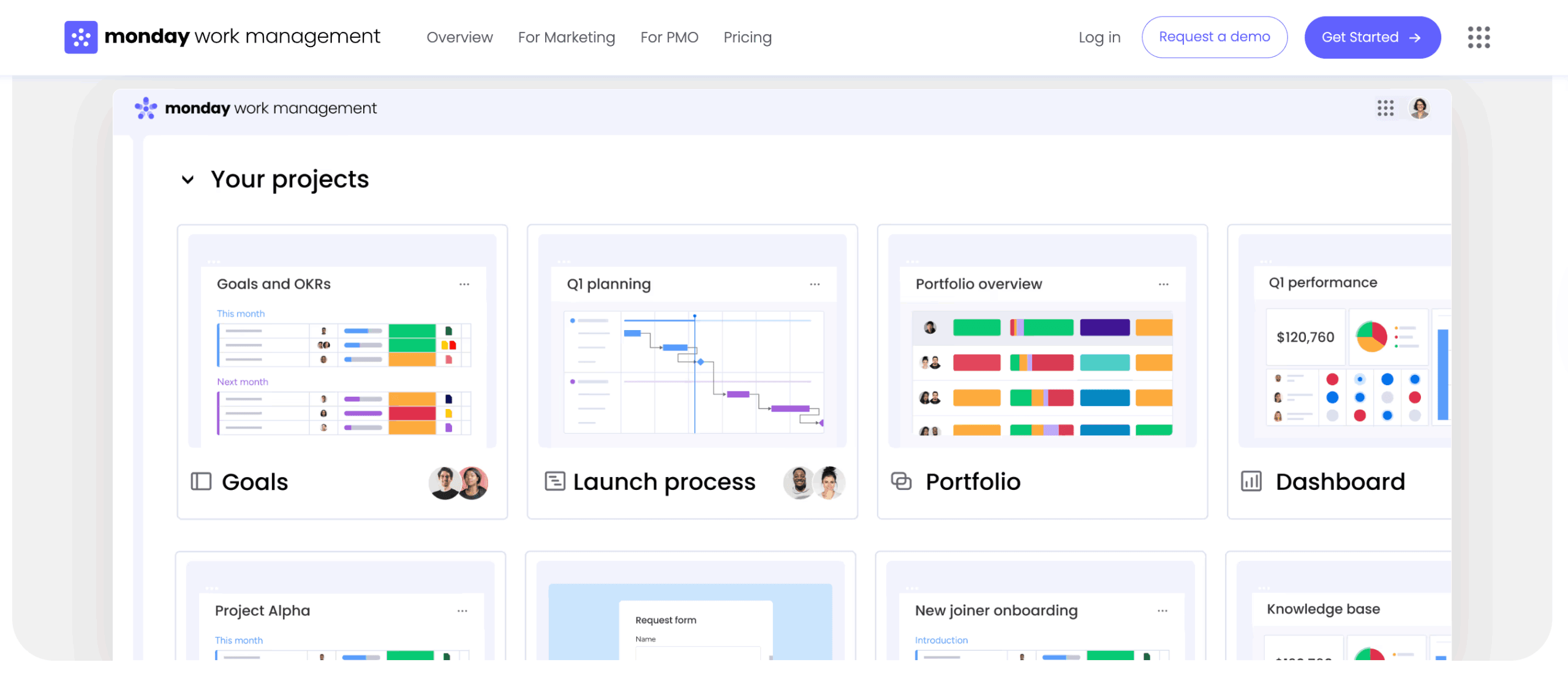
If you’re serious about changing your performance approach, you need a system that draws a clear line from your strategy to what people do every day. With monday work management, you gain a fundamentally different approach by generating insights directly from how teams execute work rather than requiring separate performance tracking.
The platform connects every project and initiative to strategic objectives within a unified workspace. When marketing teams execute campaigns, product teams ship features, or operations teams complete process improvements, the platform automatically updates progress toward relevant goals. This automatic connection between execution and performance eliminates the manual goal tracking that consumes manager time in traditional systems.
Performance visibility emerges naturally from work transparency. Leaders can see real-time progress across all initiatives through customizable dashboards that aggregate data from every team and project. These dashboards show not just whether goals are on track but which specific work items contribute to goal progress, where bottlenecks exist, and which teams need support.
AI capabilities in monday work management transform raw work data into actionable performance insights:
- AI Blocks: Analyze project patterns to identify risks before they impact outcomes
- Resource optimization: Recommend optimal allocation based on team capacity and skills
- Trend surfacing: Identify performance improvement opportunities across the organization
Organizations using monday work management experience performance management that feels natural rather than administrative. Teams focus on executing great work while the platform captures the performance data that drives strategic decisions and individual development.
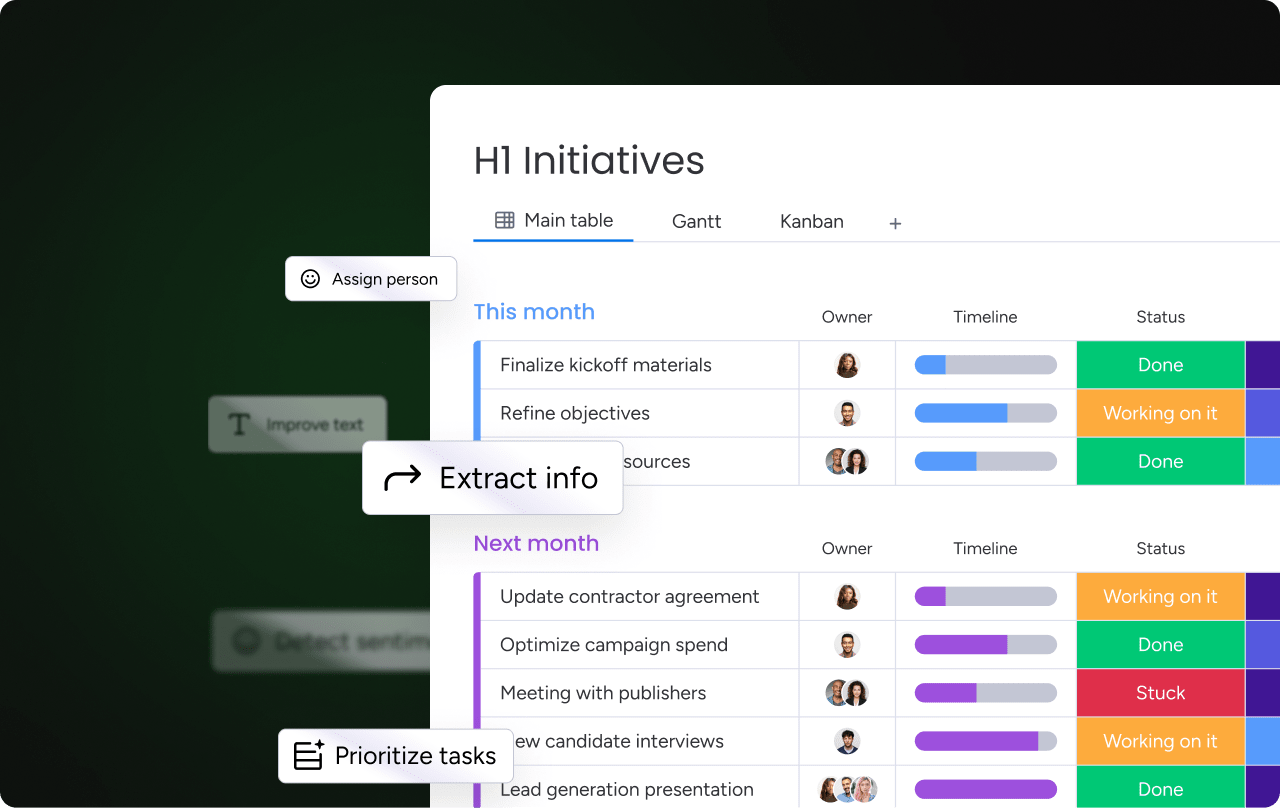
Transform how your organization manages performance
The gap between strategy and execution doesn’t close itself. Every day without a modern performance management system means missed opportunities to develop talent, align teams, and drive strategic outcomes. The question isn’t whether you need better performance visibility — it’s how quickly you can implement a system that turns daily work into measurable progress toward your most important goals.
Start building your performance management system today — monday work management takes minutes to set up and delivers visibility from day one. No separate tracking. No manual updates. Just real work connected to real goals, with the insights you need to make better decisions about your people and priorities.
Try monday work managementFAQs
What are the 5 elements of a performance management system?
The 5 core elements are strategic goal alignment, continuous performance tracking, data-driven analytics, employee development planning, and integrated recognition programs. These elements work together to create a comprehensive approach that connects individual performance to organizational success.
What are the 4 pillars of performance management?
The 4 foundational pillars are planning, monitoring, developing, and rewarding, which together create a comprehensive approach to improving employee and organizational performance. Planning establishes goals and expectations, monitoring tracks progress, developing builds capabilities, and rewarding recognizes achievements.
What is the difference between performance management and performance appraisal?
Performance management is a continuous, comprehensive approach to improving performance through ongoing goal setting, feedback, and development, while performance appraisal is a specific event where managers formally evaluate and rate past performance. Performance management encompasses the entire cycle of planning, monitoring, and developing performance.
How often should performance reviews happen?
Modern systems typically include monthly informal check-ins, quarterly formal reviews, and annual comprehensive assessments to balance continuous feedback with structured evaluation. The frequency depends on organizational needs, but most effective systems emphasize ongoing conversations rather than infrequent formal reviews.
Can small businesses implement performance management systems effectively?
Small businesses can implement effective systems by focusing on core capabilities like goal-setting frameworks, regular check-in rhythms, and basic performance tracking without the complexity that large enterprises require. The key is choosing systems that scale with growth while providing immediate value.
How do performance management systems support remote and hybrid teams?
These systems support distributed teams by providing structure, visibility, and documentation that replace informal performance signals, ensuring remote employees receive the same attention as on-site colleagues. They create consistent communication rhythms and transparent goal tracking that work regardless of location.
